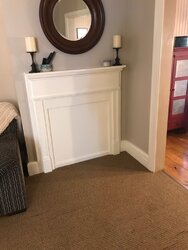Hello,
I am purchasing an older farmhouse which was built circa 1850. I noticed that the fireplace has been covered, and there is a large slate stone over the top of the chimney on the roof. The chimney is made of brick, and on the exterior appears to be in good shape. I would very much like to get the fireplace back into an operational status, but have a few questions:
1.) Why would someone block off the fireplace? Should I assume that the only reason this would be done is due to some severe damage or cost prohibitive reason? Maybe someone did not want to pay for it to be lined?
2.) I have attached a picture of the fireplace where it has been covered up. I am concerned about the clearance to the small wall on the right hand side. Is there anything I can do short of taking the wall down to address that?
3.) I would assume there is a hearth extension somewhere underneath the carpet. If not, putting one in would not be a problem. I also assume the firebox doesn't start right at the edge of the mantel, I feel like people from back in the day were much smarter than that. From what I am reading, I need 12 inches from the inside of the firebox to the upper mantel as well as that right hand wall. Can anyone confirm?
Is there anything else I am not thinking about?
Thanks for your help and opinions. Once I move in I plan to open up the fireplace to determine exactly where the firebox starts and its condition.
I am purchasing an older farmhouse which was built circa 1850. I noticed that the fireplace has been covered, and there is a large slate stone over the top of the chimney on the roof. The chimney is made of brick, and on the exterior appears to be in good shape. I would very much like to get the fireplace back into an operational status, but have a few questions:
1.) Why would someone block off the fireplace? Should I assume that the only reason this would be done is due to some severe damage or cost prohibitive reason? Maybe someone did not want to pay for it to be lined?
2.) I have attached a picture of the fireplace where it has been covered up. I am concerned about the clearance to the small wall on the right hand side. Is there anything I can do short of taking the wall down to address that?
3.) I would assume there is a hearth extension somewhere underneath the carpet. If not, putting one in would not be a problem. I also assume the firebox doesn't start right at the edge of the mantel, I feel like people from back in the day were much smarter than that. From what I am reading, I need 12 inches from the inside of the firebox to the upper mantel as well as that right hand wall. Can anyone confirm?
Is there anything else I am not thinking about?
Thanks for your help and opinions. Once I move in I plan to open up the fireplace to determine exactly where the firebox starts and its condition.


